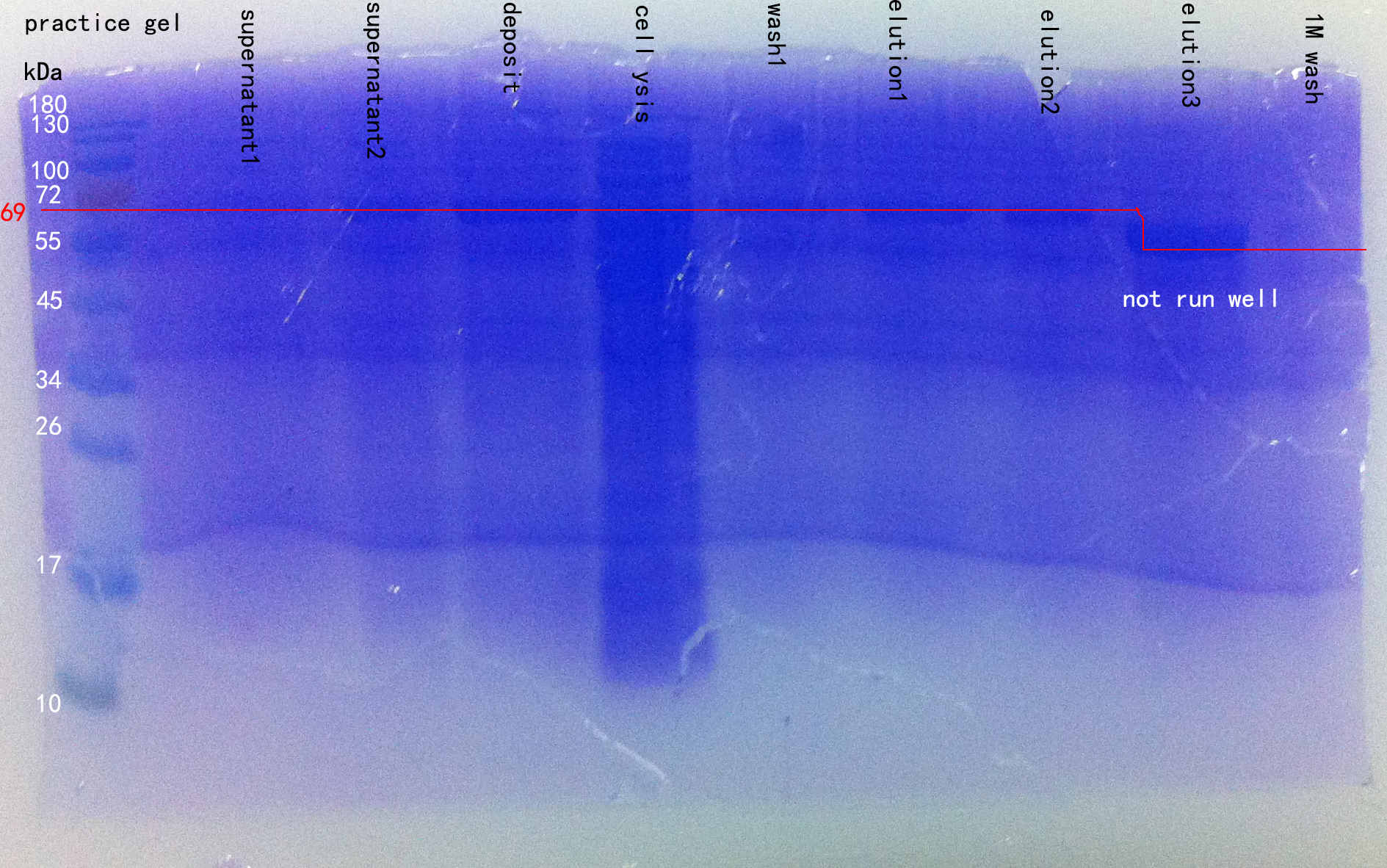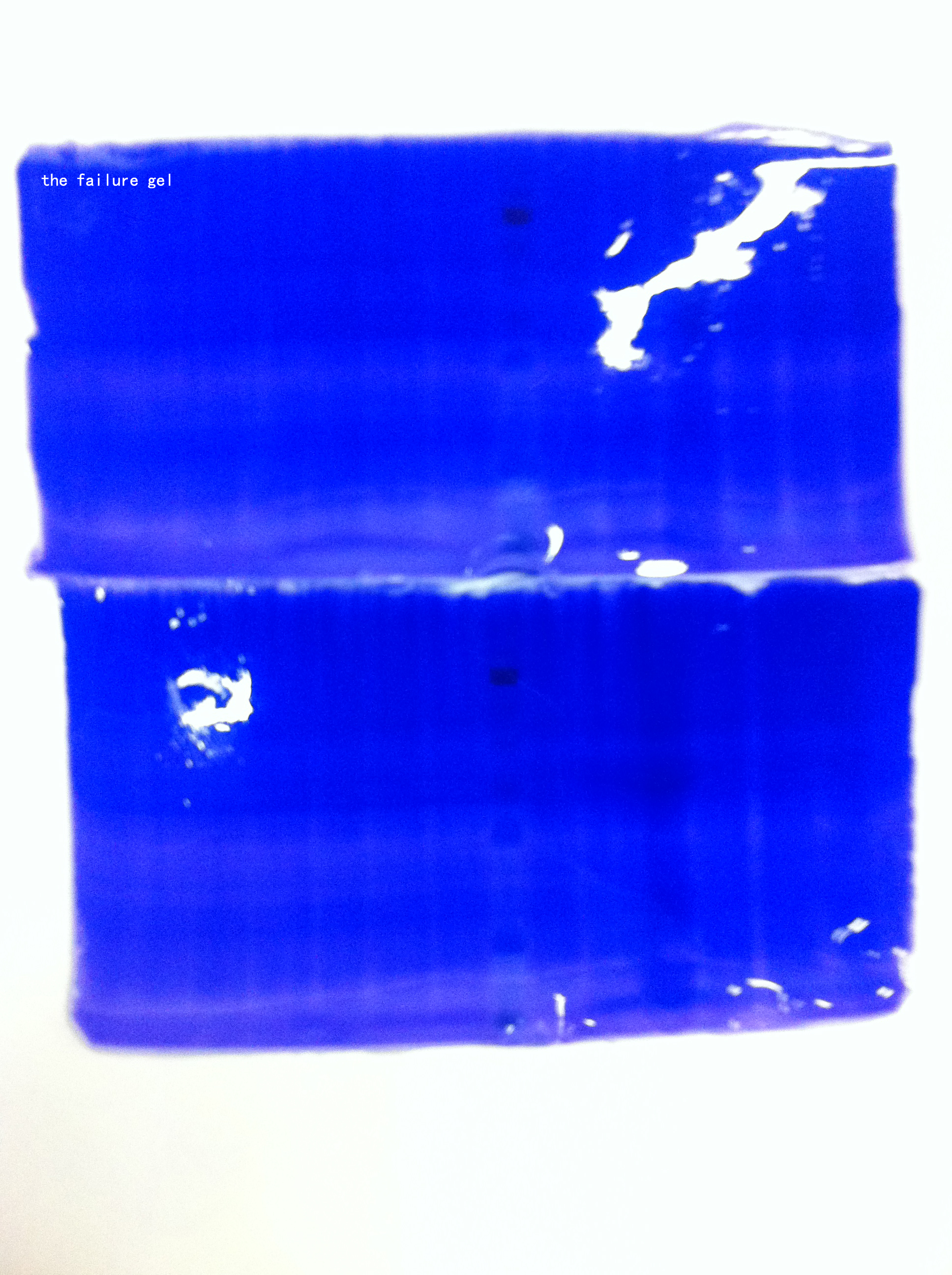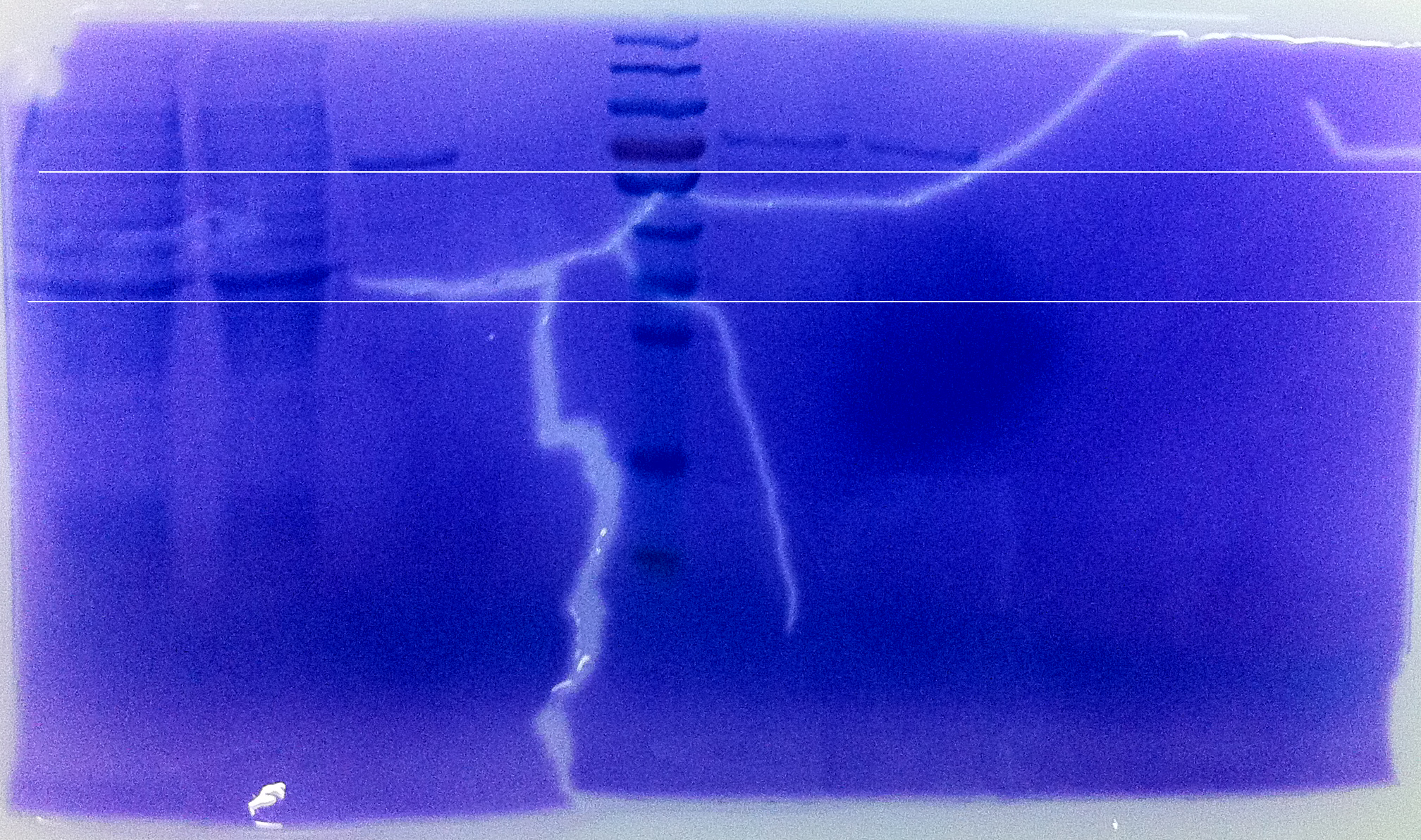Team:SUSTC-Shenzhen/Notebook/A-B Toxin/Purify
From 2014.igem.org
Notebook
Element of an endeavor
A-B Toxin
purify the protein&improve the protocolDescription
This records what we try to purify the A-B Toxin from Winfried Wels, Institute for Experimental Cancer Research, Tumor Biology Center, Breisacher Strasse 117, D-79106 Freiburg, Germany. And importantly, we have taken many improve to the protocol we got, and got many helps from the teachers and professors. Until today, we extract a large amount of proteins and tried in the hela cell.
 Figure 1. this is the coding sequence of pWF47-TEG, which has flag, DNA binding domain, translocation domain, receptor binding domain and ect.
Figure 1. this is the coding sequence of pWF47-TEG, which has flag, DNA binding domain, translocation domain, receptor binding domain and ect.
 Figure 2. this is the coding sequence of pSW55-GD5, which has the similar domain as the TEG coding sequence.
Figure 2. this is the coding sequence of pSW55-GD5, which has the similar domain as the TEG coding sequence.
Practice(8.16~8.22)
2014.8.16
Because of our plasmid can only form inclusion body in the E.coli, we decide to use a plasmid which can produce inclusion body in the E.coli.
Incubate the transformed bacteria(DH5α) in the incubator.(plasmid is a eukaryotic protein and will form inclusion body, size is about 69kDa)
Transformation: https://2014.igem.org/Team:SUSTC-Shenzhen/Notebook/Preparation_work#bacteria_transformation
2014.8.17
- Select the single colony in the plate of DH5α, and add 100 µg/ml ampicillin 300ul LB medium.
- After shake it in the 37 ºC shaker for 12hrs, use the TIANprep Rapid Mini Plasmid Kit(TIANGEN○R) to extract the plasmid.
- Transform the plasmid into the BL21.
- Incubate it in the 37 ºC incubator for 12hrs.
2014.8.18
- select the single colony on the plate and use 250ml 100 ug/ml ampicillin LB medium to incubate it.
- Make the protein extract buffer
2014.8.19
Extract the protein from the broth.
- Harvest the cell at 4C by centrifugation at 9000rpm for 15 min.
- Resuspend the cell in 27ml lysis buffer (1g cells = 25ml lysis buffer)
- Thel cells are lysed by sonication for 3 min on ice (5s on, 3s off)
- The lysate is gently shaken for 1.5 h at room temperature (26ºC)
2014.8.20
Use the Ni2+ column to purify the protein
https://2014.igem.org/Team:SUSTC-Shenzhen/Notebook/A-B_Toxin/Ni_Column#Purification_of_Protein
2014.8.21
- make the 10%SDS
- make the 10%APS(Ammonium Persulfate)
- make the Coomassie Brilliant Blue
- Use the SDS-PAGE to run the protein sample
https://2014.igem.org/Team:SUSTC-Shenzhen/Notebook/A-B_Toxin/SDS_PAGE#protocol
2014.8.22
- Run the sample on the gel
Result
Fig.3 2014.8.21.We can clearly see that there is several deep-colored band in the gel, we can easily infer that these are the wanted band. But also, in the purified band, there is still some impurity band, which means that our Ni purify technique is not so good.
Fig.4 2014.8.22 we can see more clearly from these gel, the concentration of protein seems well, but the purification is not so good. And the last band looks run quicker than the other gel, possibly because this sample is more dense.
The primary extract of A-B Toxin(8.23-8.26)
preliminary purification of chimeric fusion protein: GD5 and TEG
Materials
Plasmid pSW55-GD5(chimeric fusion protein carries a yeast transcription factor Gal4,an antibody fragment specific for the tumor-associated ErbB2 antigen and an internal DT translocation domain)
Plasmid pWF47-TEG(chimeric fusion protein carries a yeast transcription factor Gal4, an EGF receptor ligand TGF-a, and an internal Pseudomonas exotoxin A translocation domain)
DH5-a,
BL21,
Amp LB plates,
100ug/ml ampicillin LB liquid media,
TIANprep Rapid Mini Plasmid Kit(TIANGEN○R),
100ug/ml ampicillin LB liquid media containing 0.6% glucose,
Lysis buffer: 50 mM Tris-HCl, pH 8.0, 150 mM NaCl, 10 µM ZnCl2, 0.3 mM PMSF, 8 M urea
Binding buffer: 50 mM Tris-HCl, pH 8.0, 150 mM NaCl, 10 µM ZnCl2, 0.3 mM PMSF, 8 M urea, 10 mM imidazole
Wash buffer: 50 mM Tris-HCl, pH 8.0, 150 mM NaCl, 10 µM ZnCl2, 0.3 mM PMSF, 8 M urea, 50mM imidazole
Elution buffer: 50 mM Tris-HCl, pH 8.0, 150 mM NaCl, 10 µM ZnCl2, 0.3 mM PMSF, 8 M urea, 250 mM imidazole
Cleansing buffer: 50 mM Tris-HCl, pH 8.0, 150 mM NaCl, 10 µM ZnCl2, 0.3 mM PMSF, 8 M urea, 1 M imidazole
Ni2+ affinity chromatography
Methods
2014.8.23
1.We got the plasmids of GD5 and TEG from Winfried Wels, Institute for Experimental Cancer Research, Tumor Biology Center, Breisacher Strasse 117, D-79106 Freiburg, Germany
2.Transform these two plasmids into DH5-a, and incubated at Amp LB plates over night at 37 ºC.
2014.8.24
1.Pick up a single colony of TEG and of GD5
2.Transform these two colonies into 100 µg/ml ampicillin LB liquid media, grow 12h at 37 ºC, 200rpm
3.Extract plasmids GD5 and TEG by TIANprep Rapid Mini Plasmid Kit(TIANGEN○R)
4.Transform plasmids GD5 and TEG to BL21, grow overnight at Amp LB plates at 37 ºC
2014.8.25
1. Pick up single colony of plasmids GD5 and TEG to 2 ml LB medium containing 100 µg/ml ampicillin and 0.6%glucose and grow 2.5h at 37 ºC and 200rpm (11:15am)
2. Dilute the culture to 100ml l fresh in LB medium containing 100 µg/ml ampicillin and 0.6 % glucose , grow at 37 ºC to an OD600 of 0.6 (2:00pm)
3. TEG OD600=0.30, GD5 OD600=0.38 (3:50pm)
4. TEG OD600=0.38, GD5 OD600=0.51 (5:00pm)
5. TEG OD600=0.55, GD5 OD600=0.64 (6:00pm)
6.Add IPTG to a final concentration of 0.5mM and expression is induced for 1.75h at 37 ºC, 200rpm (6:10pm)
7. The cells were divided into 6 centrifuge tubes( 7:55pm)
8. Harvest the cell at 4C by centrifugation at 9000rpm for 15 min. (8:30pm)
9. Resuspend the cell in 27ml lysis buffer (1g cells = 25ml lysis buffer)
10. Thel cells are lysed by sonication for 3 min on ice (5s on, 3s off) (10:10pm)
11. The lysate is gently shaken for 1.5 h at room temperature (26 ºC)
2014.8.26
12. Centrifuged the cells at 4 °C in for 40 min at 9200rpm and then collect the supernatant (8.27 0:40am)
13. Repeat step 12 (1:40am)
14. The supernatant is collected, 10 mM imidazole final concentration is added and stored at 4°C. (2:00am)
15. Purify GD5 and TEG via Ni2+ affinity chromatography by the protocol Purification of the chimeric fusion protein via Ni2+ affinity chromatography
16. Proteins GD5 and TEG are determined by SDS-PAGE and Coomassie brilliant blue staining
Results:
Supposed Results:
We can see only one band in the elution samples of TEG and GD5, TEG is 38kDa, GD5 is 68kDa
Actual Results:
Fig.5 Schematic representation of the TEG fusion gene in the E.coli expression plasmid pWF47-TEG
Fig.6 E.coli which expressed plasmid pSW55-GD5
Fig.7 these are the first gels we got, it looks so unclear.
Then, we improved our method to wash the stained gel, use destain buffer to heat in microwave oven for 5min, and then use ddH2O to heat in the microwave oven. The results are better than before.
Fig.8 we can see that in the 69kDa, there are band in the elution2,3,4 sample, it means, that the protein was presented by the bacteria. But the color of bands are not so deep, so the concentration may not reach our requirement.
Fig.9 similar to fig.8 , but the TEG protein is in the band of 43kDa, the color of TEG looks more deeper than GD5, but there are bands look like GD5 in the TEG protein. May be when we use the ddH2O to collect the plasmid on the letter, the TEG plasmid is mixed with few GD5 plasmid.
Protein concentration measurement
Both consider the accuracy and complication of the procedure, we did not use the western-blot or the nanodrop but the Bradford assay.
2014.9.2
Make the principle curve and compare the sample with the BSA data. https://2014.igem.org/Team:SUSTC-Shenzhen/Notebook/A-B_Toxin/Bradford#Protocol
Result
Their data look not so good, apart from the TEG elution3(A=0.198,c=2.6643ug/ml) and GD5 elution3(A=0.129,c=1.0096ug/ml),other all below the 0.050, and this can not be transformed to an effective value.
Primary Refolding(2014.9.4~9.6)
2014.9.4~9.5
- Use the 0.3mM DDT to deal with the purified protein sample for 2hrs
- for 2ml purified sample, add about 0.6ul 1M DDT to the sample.
- Use the refolding buffer to deal with it for 2 days(the sample concentration must lower than 100mg/ml)
Composition
Refolding buffer: 100mM tris-HCl, 8mM oxidized glutathione, 0.5M L-arginine, 150mM NaCl
2014.9.6
Run the SDS-PAGE to test if the protein has activity or not.
Result
In this procedure, we got a mistake that we thought this process of just reduced the disulfide bonding as a operation of dilution refolding. So we haven’t gotten any effective results in this primary try.
Second try(2014.8.31~2014.9.4)
Background
Because of the first success (can purify protein at initial time), we decide to take forward, to search more suitable imidazole gradients.
Change
We change the gradient of wash and elution gradients, use a gradient of 10mM, 50mM, 90mM, 180mM, 250mM, 330mM.
Result
What’s a pity is that, the result is strange!
Fig.10 purification of protein looks well, but in the elution gradient, for the second 250mM, is no band, this is very strange 330mM have the band, it may the wrong sample position. Even though, the result is not so good, because the concentration is lower than before.
Fig.11 the GD5 is also similar to the TEG, and meanwhile, the concentration of elution protein is lower than GD5 according to the Bradford results. And we can see in the gel, the band of GD5 can nearly ignored.
Third try(2014.9.8~2014.9.13)
Background
We concluded that in the two attempts, we had many wrong and bad operation, and in this day we did a second attempt.
We did some improvement to the procedure:
- the time of centrifuge to harvest the cell, we decrease it to 4000 rpm, because it did not need 9000 rpm to harvest the cell(E.coli is easy to harvest), and the over high speed is harmful to the machine.
- the Ni2+ column purify, we didn’t filter in the primary try, and the impurity will affect the column
- the first refold, we made a mistake as we said before, we changed it and after the reduction ,we did the dialysis refolding.
- the second purify, we can nearly ignore the concentration of proteins. It looks that the concentration we used in primary try is good enough.
Result
We posit a wrong position, mix up the elution result and the protein sample. Add the TEG elution to the GD5 gel. add TEG elution to the GD5 gel.
Fig.12 The TEG concentration and purification is good enough compared to the former data. But due to the dialysis band is not arriving at our lab, we cannot do the dialysis, and we put the sample in the 4 ºC
Fig.13 The GD5 concentration is still not good.
Forth try(2014.9.22~2014.9.30)
Background
Repeat experiment, due to the low concentration of protein, we enlarge the system of broth to 2L, which means that for each protein we make a 2L broth.
Result(Get it in 9.26)
For any reasons, we got only GD5 gel, the TEG gel was destroyed before recording, the TEG results are good.
Fig.14 more normal, and with several impurity band
Due to the good results and our dialysis membrane have been received 1day ago. We can use these sample to do the dialysis.
Select the deep color GD5 band to do the Bradford,
| E2 | E4 | E6 | E8 | E10 |
|---|---|---|---|---|
| 0.600 | 0.769 | 0.755 | 0.404 | 0.369 |
| 45ug/ml | 55 ug/ml | 55 ug/ml | 15 ug/ml | 15 ug/ml |
Second dialysis(9.26~9.28)
Materials
Refolding buffer1(to remove the urea):
50mM Tris-HCl, 50mM KCl, 5mM MgCl2, 10mM ZnCl2, 20% glycerol, 400mM L-argine
Refolding buffer2(to remove the L-argine)
The refolding buffer1 without L-argine.
Results
The system volume in concentrated to 1/5 of origin.
Fig.15 GD5:normal,in the right
TEG:the protein disappear, and use Bradford can not get any signals. But before the dialysis, the protein still existed. in the left
| TEG | absorption (OD) |
|---|---|
| before dialysis | 0.151 |
| after dialysis | 0.010 |
| GD5 | |
| before dialysis | 0.622 |
| after dialysis | 0.225 |
Ask for help(2014.10.1~2014.10.2)
Without any ideal results, we visit professor Hongming Zhang, who is concentrate on the structure of protein analysis, and have rich experience of purify of protein.
He gave us mainly two advices, we can just do not add urea to in the cell lysis system and just use DNase, RNase, Protease and lysozyme to deal with the lysis, and use some low salt buffer to wash and centrifuge it, remove the supernatant and remain the deposit in the every step. At last, when the deposit become white and pure, using buffer contain urea to dissolve it. And the concentration of protein can be control and largely improved.
another one is that when we use the Ni column, we can not mix up when doing elution, and let the elution buffer flow out, and in the collected solution, the protein will be concentrated in two or three elution sample.
Fifth try(2014.10.2~2014.10.11)
Background
This experiment happen in the National holiday, and we can explore different methods to purify and refold the protein. We two persons divide into two direction to do the experiments. Long will do the repeat experiments and improve it. Su will do the new method that Prof.Zhang told us.
Protocol of Zhang’s
https://2014.igem.org/Team:SUSTC-Shenzhen/Notebook/A-B_Toxin/Modified_Protocol#Modified_Protocol
The recovery of Ni Column(2014.10.5)
After two month’s use, we do a recovery of Ni Column to keep its activity. https://2014.igem.org/Team:SUSTC-Shenzhen/Notebook/A-B_Toxin/Nickel_Column_Recovery#protocol
DNA drift assay&NATIVE-PAGE
To test the DNA-protein binding activity, we use the NATIVE-PAGE(which mainly differ from SDS-PAGE is that NATIVE-PAGE does not have DTT and SDS)
| UAS sequence | concentration(ug/ml) | plasmid(ul) | protein | ddH2O |
|---|---|---|---|---|
| 0X | 453.7 | 2.4 | 10 | 7.6 |
| 2X | 644.1 | 1.7 | 10 | 8.3 |
| 5X | 107.1 | 10 | 10 | 0 |
| 7X | 439.3 | 2.4 | 10 | 7.6 |
Fig.16 have no band, which means that there is no drift between DNA and this protein, maybe our protein did not refold successful.
Results
Because the low efficiency of GD5, we decide to use only as the main protein we exracts After using Zhang’s protocol, our concentration have largely be increased, but with some impurity in it.
Modified protocol
Fig.17 looks very dense but concentrated
Fig.18 the purified protein, measurements show that the concentration had some kind of decrease.
Original protocol
Fig.19 the concentration is lower than the modified protocol’s.
The analysis of results before(2014.10.12)
We have gotten a suitable concentration of protein by the modified Zhang’s protocol, but it is still a problem that the activity of protein after dialysis is too low. But it just have a little for us to upload our results, Asking the Professor Cong Yu, we decided to do two methods to refold, Su use the dialysis, and it will be longer but will be more hopeful, Long use the Yu’s advice, he will do the refold when flow out through the Ni Column, it will be shorter and quicker.
Sixth try—not the last try(2014.10.13~2014.10.16)
Background
The more important thing changed to the how to refold the protein and make it active, Su will do the Zhang’s method and Long will do a new method that Prof.Yu told.
Protocol of Yu’s
Ni Column refolding, it’s easy. Just need to add the refolding buffer when we did the elution of Ni Column.
Results
What we did not think of is that the refolding buffer have made before have EDTA, the protein flow out with Ni and other things, but we collect all the buffer, and use the super filter (10kDa) to concentrate the solution. And without a test, we give it to the Hela cell group to test if it can do the transformation.
Fig.20 the concentration is good and we got protein to do the dialysis.
The elution concentration
| num | 1 | 2 | 3 | TEG | 0.455 | 0.525 | 0.820 |
|---|
The dialysis concentration
| protein | absorption | concentration(ug/ml) | TEG | 0.690 | 45 |
|---|
DNA drift assay
Plasmid
| plasmid | 2XUAS | 5XUAS | 7XUAS |
|---|---|---|---|
| size/bp | 5107 | 5209 | 5243 |
| concentration/(ng/ul) | 644 | 459.5 | 439.5 |
Primer
| plasmid | 2XUAS | 5XUAS |
|---|---|---|
| size/bp | 162 | 224 |
| concentration/(ng/ul) | 13.5 | 12.2 |
Biobrick
| plasmid | 5XUAS | 7XUAS |
|---|---|---|
| size/bp | 2174 | 2236 |
| concentration/(ng/ul) | 293.4 | 314.7 |
Results
| plasmid 2XUAS | plasmid 5XUAS | plasmid 7XUAS | primer 5XUAS | primer 7XUAS | bba 5XUAS | bba 7XUAS | |
|---|---|---|---|---|---|---|---|
| volume of dna(ul) | 0.49 | 0.7 | 0.74 | 0.741 | 1.135 | 0.458 | 0.44 |
| volume of protein(ul) | 16.10 | 16.09 | 16.16 | 16.07 | 16.11 | 16.22 | 16.14 |
Conculsion
although we do not successful refold the A-B Toxin, but from the results from the essay, we can infer that use this part as a tool to transport plasmid is very possible to realize. And our cell line building initially prove the possibility of our Project, if give us more time , we will approach the results we design, after the wiki finished, we will try our best to purify this protein in the last 10 days.
 "
"















